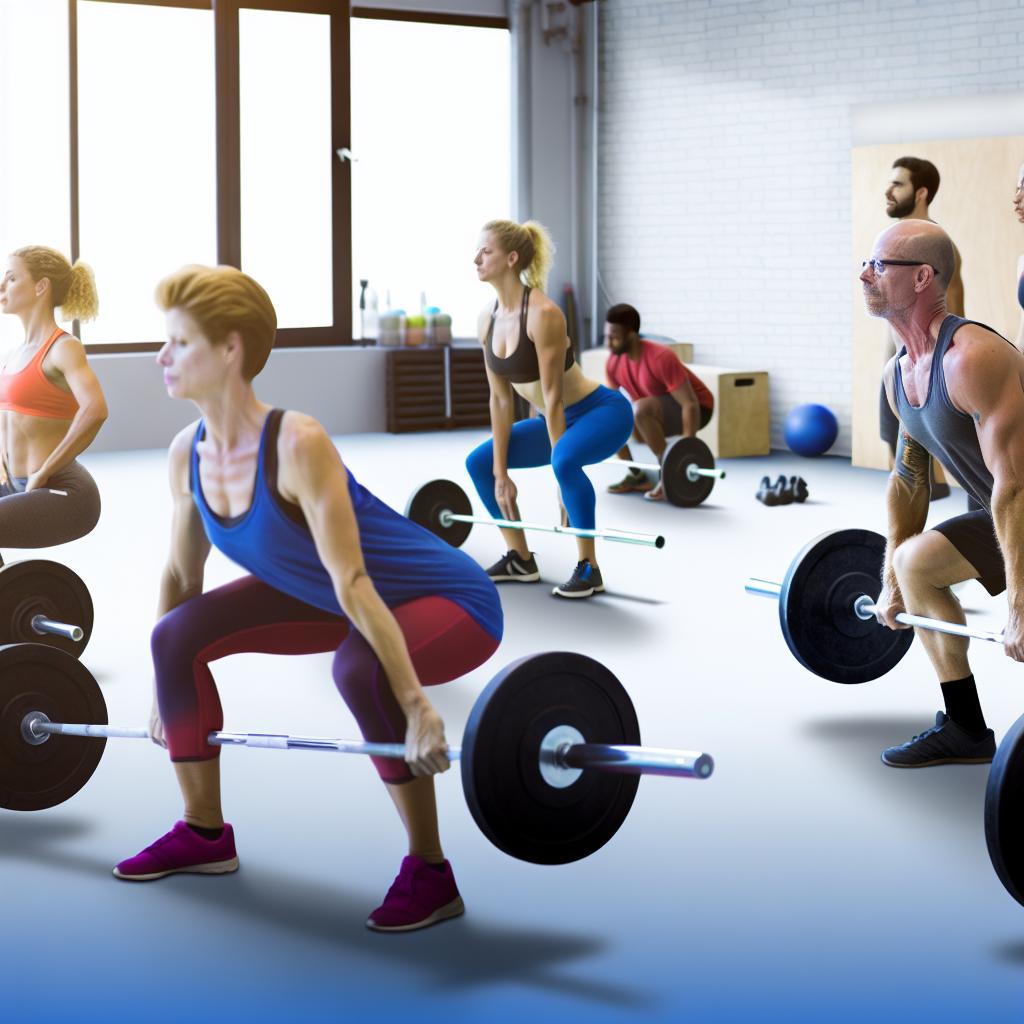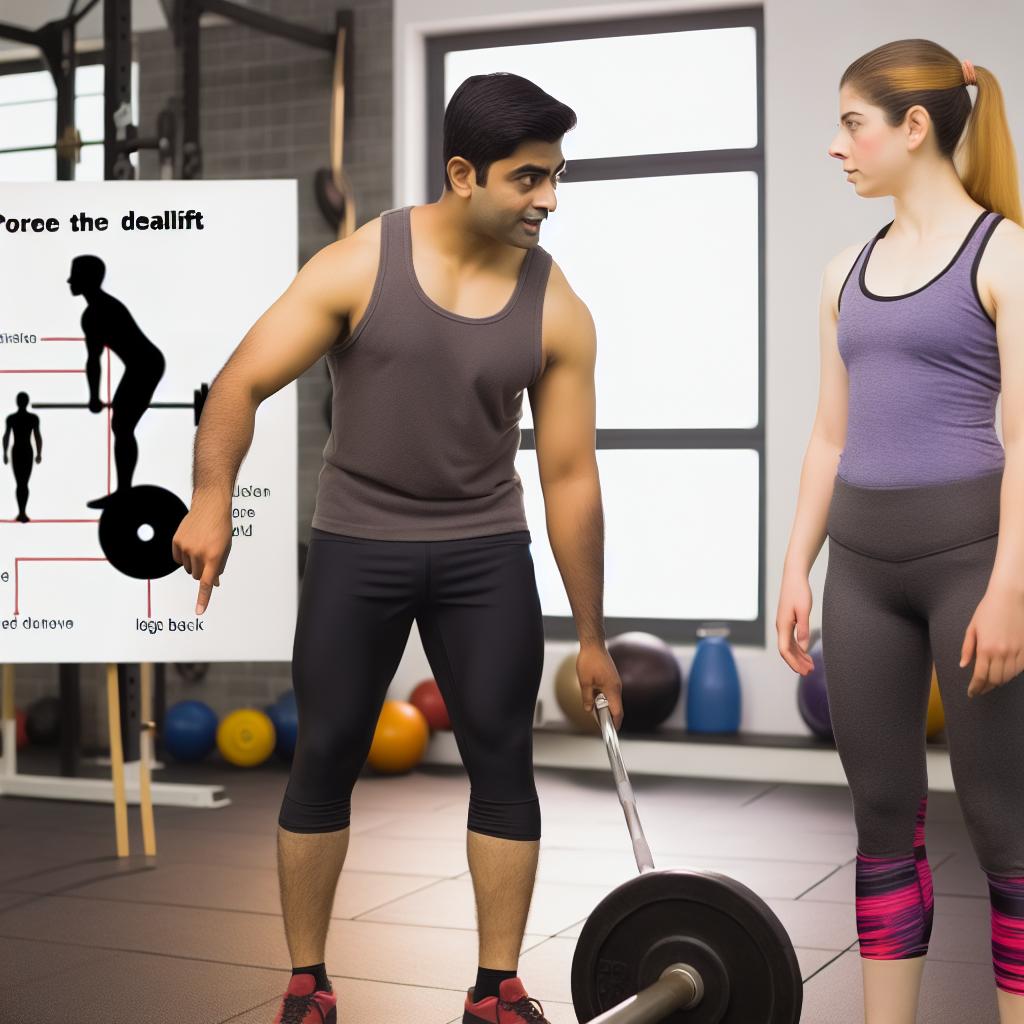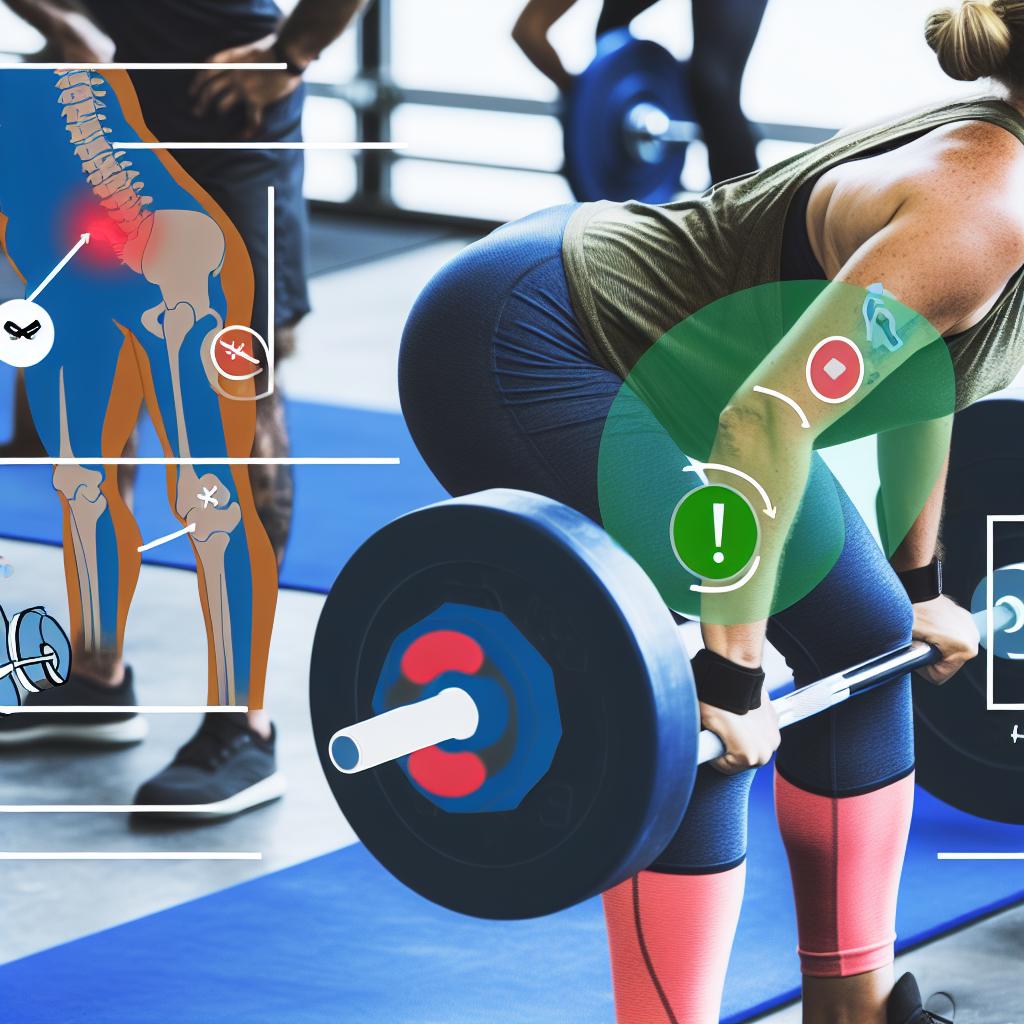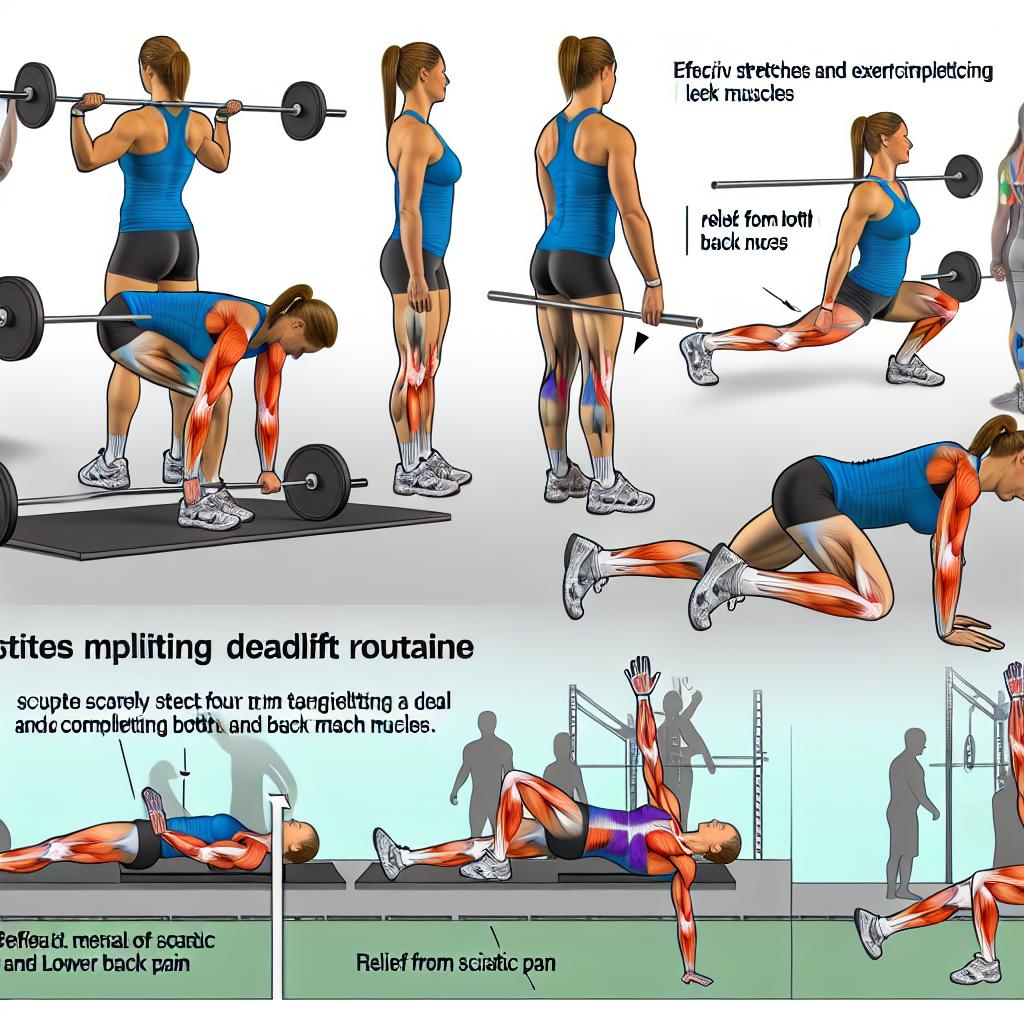The deadlift frequently enough sparks debate among fitness enthusiasts: is it primarily a leg or back exercise? This discussion is crucial,as understanding its mechanics can influence your training routine and muscle development. By examining the engagement of both lower and upper body muscles during the lift, we can clarify its multifaceted role in strength training.
## Understanding the Deadlift: A Comprehensive Overview of ‘Is Deadlift a Leg or Back Exercise? Understanding Its Role
Deadlift as a Dual-Action Exercise
The deadlift is unique in its ability to together target both the lower body and the back, making it a highly effective compound exercise. While primarily recognized for its emphasis on the posterior chain—including the hamstrings, glutes, and lower back—it also engages the upper back, traps, and lats as you lift and stabilize the weight. This dual engagement highlights why many fitness enthusiasts frequently enough struggle to classify the deadlift strictly as either a leg or back exercise.
Muscle Engagement Breakdown
Understanding which muscles are activated during a deadlift can help you tailor your workouts effectively. Hear’s a concise breakdown:
- Legs: Primarily, the deadlift targets the glutes and hamstrings, powering the lift from the ground.
- Back: The erector spinae and upper back muscles work synergistically to maintain stability and posture throughout the movement.
- Core: A strong core is essential for supporting the spine and enhancing overall performance during the lift.
Incorporating Deadlifts into Your Routine
Given its comprehensive muscle engagement, consider these actionable pointers for incorporating deadlifts into your workout regimen:
- Include deadlifts on leg days for a focus on lower body development.
- Integrate them into back days to improve upper back strength and overall posture.
- perform variations such as Romanian deadlifts or sumo deadlifts to emphasize different muscle groups.
Ultimately, the deadlift should be viewed as a multi-faceted exercise that can enhance your overall strength and performance, making it a valuable addition to your fitness program.
## The Primary Muscles Involved in the Deadlift: Anatomy of ‘Is Deadlift a Leg or Back Exercise? Understanding Its Role
Understanding the Muscle Groups
The deadlift is a compound exercise that primarily targets several muscle groups. It primarily engages the leg muscles, specifically:
- Glutes: Powerful muscles that are basic for hip extension.
- Hamstrings: Essential for bending the knees and helping drive the movement upward.
- Quadriceps: Engaged during the initial lift-off from the ground.
In addition to the lower body,the deadlift also heavily recruits muscles in the back:
- Erector Spinae: A group of muscles that run along the spine,crucial for maintaining an upright posture during the lift.
- Trapezius: Stabilizes the shoulder blades, allowing for better lifting form.
- Latissimus Dorsi: Helps in stabilizing the torso and assists in pulling movements.
Which Exercise Classification is Correct?
While the deadlift activates both legs and back muscles substantially,it is indeed frequently enough classified as a hip-dominant exercise. This classification emphasizes its functionality in activating the large muscles of the posterior chain. Thus, one could argue it serves as a hybrid exercise benefiting both the legs and back. Understanding this dual role is crucial for athletes and fitness enthusiasts looking to optimize their training routines.
## Identifying the Variants of Deadlifts: Exploring ‘Is Deadlift a Leg or Back exercise? Understanding Its Role
Understanding the Deadlift’s Role
the **deadlift** is a unique compound exercise that engages both the posterior chain and the lower body, making it essential for overall strength development. While it predominantly targets the **back muscles**, including the latissimus dorsi and erector spinae, it also involves significant contributions from the **legs**, particularly the hamstrings and glutes. This dual action is why the deadlift is often debated as either a back or leg exercise.
Benefits of the Deadlift
Engaging in deadlifts offers numerous benefits:
- **Strength Development**: Enhances overall strength by engaging multiple muscle groups.
- **core Stability**: Strengthens the core by requiring stabilization throughout the movement.
- **Functional Movement**: mimics natural lifting motions, improving daily life activities.
Key Variants of Deadlifts
Several deadlift variants can emphasize different muscle groups:
- **Conventional Deadlift**: Primarily targets the back and legs.
- **Sumo deadlift**: Focuses more on the legs due to a wider stance.
- **Romanian Deadlift**: Stresses the hamstrings and lower back.
Incorporating Deadlifts into Your Routine
To reap the benefits of deadlifts effectively, follow these steps:
- **Warm-Up**: Engage in dynamic stretches and light cardio to prepare your muscles.
- **Choose the Right Variant**: Select a deadlift type based on your fitness goals.
- **Focus on Form**: Ensure proper technique to avoid injury and maximize efficiency. Maintain a neutral spine and engage your core.
- **Progress gradually**: Start with lighter weights and gradually increase as your technique and strength improve.
## Practical Solutions for Proper Deadlift Technique: Master ’Is deadlift a Leg or Back Exercise? Understanding Its Role
Understanding the Deadlift’s Muscular Focus
The deadlift is a compound exercise that intricately engages both the legs and the back, making it a **total-body workout**.This exercise targets major muscle groups including the hamstrings, glutes, and lower back, while also activating the upper back and core.
When performing a deadlift, the emphasis can shift depending on your form and stance:
- Conventional Deadlift: Primarily emphasizes the posterior chain, focusing on the hamstrings and lower back.
- Sumo Deadlift: Places a greater emphasis on the quadriceps and inner thighs due to the wider stance.
Key Muscles Engaged
| Muscle Group | Primary Role |
|---|---|
| Hamstrings | Primary movers; crucial for lifting the weight. |
| Glutes | Assist in hip extension, stabilizing the lift. |
| Lower Back (Erector Spinae) | Provides stability and strength during the lift. |
| Core | supports overall body alignment and stability. |
Practical Tips for Proper Technique
To master the deadlift, focus on these essential techniques:
- Set Your Stance: Position your feet hip-width apart with the barbell close to your shins.
- Engage your Core: Tighten your abdominal muscles before lifting to maintain stability.
- Keep your Back Flat: Avoid rounding your back; maintain a neutral spine throughout the movement.
- Push Through Your Heels: Drive the weight upward by pushing through your feet, engaging your legs.
As you develop your deadlift technique, continually ask yourself whether you are prioritizing leg engagement or back strength, and adjust your form accordingly to achieve your fitness goals.
## addressing Common Challenges: what to Consider When Asking ‘Is Deadlift a Leg or Back Exercise? Understanding Its Role
Understanding Muscle Engagement
The deadlift is frequently enough debated as either a leg or back exercise due to its comprehensive muscle engagement. Primarily,it targets the posterior chain,which includes the hamstrings,glutes,and lower back. when performing a deadlift, you are not only strengthening your legs but also engaging major muscles in your back, including the latissimus dorsi and trapezius. This combination makes the deadlift a vital full-body exercise that promotes overall strength and stability.
Primary Muscles Worked
- Hamstrings
- Glutes
- Lower back (Spinal erectors)
- Upper back (Trapezius,rhomboids)
- Core muscles
Incorporating Deadlifts into Your Routine
When deciding whether to place deadlifts on your leg day or back day,consider the following:
- Leg day: Some fitness enthusiasts prefer to include deadlifts on leg day,as they significantly engage the lower body muscles.
- Back Day: Alternatively, others place deadlifts on back day because of the concentrated work done on the upper and lower back muscles.
Ultimately, the choice is subjective and should align with your individual training goals and how your body responds to the exercise.
Common Challenges and Considerations
When performing deadlifts, many face issues related to form and technique, which are crucial for maximizing benefits and minimizing injury risks. To address common challenges:
- Ensure your feet are shoulder-width apart, and grip the bar just outside your knees.
- Keep your back straight and chest up throughout the lift.
- Engage your core before lifting to provide stability.
Consider incorporating mobility work and specific stretches to improve your range of motion and support your deadlift performance.
## Actionable Steps for Injury Prevention: safeguarding Against Risks in ’Is Deadlift a Leg or Back Exercise? Understanding Its Role
Proper Lifting Technique
mastering the deadlift technique is crucial for preventing injuries. follow these guidelines to ensure safe lifting:
- Foot Placement: Stand with your feet hip-width apart, positioning the barbell over your midfoot.
- Grip: Use an overhand grip, or a mixed grip for heavier lifts, ensuring your hands are just outside your knees.
- Back Position: Keep your back neutral—avoid rounding your spine.
- Drive up: Lift the bar by pushing through your heels and extending your knees, while keeping the bar close to your body.
Warm-Up and Flexibility Exercises
A proper warm-up can significantly reduce the risk of injury. Incorporate these stretches before your deadlift sessions:
- Hip Flexor Stretch: Kneel on one knee and push your hips forward, holding for 20-30 seconds on each side.
- Hamstring Stretch: Sit with one leg extended and reach towards your toes,holding for 20-30 seconds.
- Spinal Mobility: Perform cat-cow stretches to enhance spinal flexibility and prepare your back.
Progressive Loading and Recovery
Gradually increase the weight you lift to allow your body to adapt and strengthen:
- Start Light: Begin with weights that you can lift comfortably while maintaining proper form.
- Incremental Increases: Increase the weight in small increments (5-10% at a time) as you build strength.
- Recovery Duration: Allow adequate rest between deadlift sessions to prevent overtraining—aim for at least 48 hours.
## Effective Stretches and Exercises to Complement Your Deadlift Routine: Enhancing ‘Is Deadlift a Leg or Back Exercise? Understanding Its Role
Understanding the Deadlift: Leg vs. Back Focus
The deadlift is a complex movement that engages both the lower body and the back, making it essential to incorporate specific stretches and exercises that enhance performance and reduce the risk of injury. While primarily targeting the legs—especially the hamstrings, quadriceps, and glutes—it also significantly activates the lower back and core muscles.
Effective Stretches for Deadlift Preparation
To optimize your deadlift routine, consider the following stretches that focus on both the legs and the back:
- Hip Flexor Stretch: Kneel on one knee, push your hips forward, and hold for 20-30 seconds on each side.
- Hamstring stretch: Sit with one leg extended and the other bent. Reach for your toes on the extended leg for 20-30 seconds.
- Child’s Pose: Kneel and sit back on your heels, extending arms forward on the floor.Hold for 30 seconds to stretch the lower back.
Complementary Exercises for Strengthening
Incorporate these exercises to reinforce the muscles used in deadlifts:
- Romanian Deadlifts: Focus on your hip hinge to strengthen hamstrings and glutes.
- Good Mornings: With a barbell across your shoulders, hinge at the hips while keeping your back straight to target the lower back.
- Single-Leg Deadlifts: Improve balance and unilateral leg strength by performing deadlifts on one leg.
| Exercise | Target Muscles | Repetitions |
|---|---|---|
| Hip Flexor Stretch | Hip Flexors | 2 sets of 30 seconds per side |
| Romanian deadlift | Hamstrings,Glutes | 3 sets of 8-10 reps |
| Single-Leg Deadlift | Hamstrings,Glutes,Lower Back | 3 sets of 6-8 reps per leg |
By integrating these stretches and exercises,you will enhance your deadlift performance and promote overall strength and stability,ensuring a balanced approach to training this pivotal movement.
## Tailoring Your Deadlift Program: Personalizing ‘Is Deadlift a Leg or Back Exercise? Understanding Its Role’ for Your Goals
Understanding the Deadlift’s Role
The deadlift is a compound exercise that uniquely engages both the back and leg muscles, making it crucial for overall strength training. When tailoring your deadlift program, it’s essential to recognize how you can focus on these muscle groups depending on your fitness goals. Whether aiming for increased leg power or enhanced back strength, modifying your technique and variations can help achieve desired results.
Deadlift Variations and Their Focus
To better personalize your deadlift routine,consider incorporating different variations that emphasize either leg or back strength:
- Conventional Deadlift: Primarily targets the hamstrings,glutes,and lower back.
- Sumo Deadlift: Places more emphasis on the quads and inner thighs.
- Romanian Deadlift: focuses on the hamstrings and glute activation, enhancing overall posterior chain strength.
Personalizing Your Approach
to effectively tailor your deadlift program, follow these actionable steps:
- Assess Your Goals: Define whether your priority is hypertrophy (muscle growth), strength, or endurance.
- modify Repetitions and Sets: Use lower reps with heavier weights for strength,and higher reps with lighter weights for endurance.
- Incorporate Accessories: Include exercises like squats,lunges,or rows to complement your deadlift focus and ensure balanced muscle development.
Sample Weekly Deadlift Program
| Day | Exercise | Sets | Reps |
|---|---|---|---|
| Monday | Conventional Deadlift | 4 | 6 |
| Wednesday | Romanian Deadlift | 3 | 10 |
| Friday | Sumo Deadlift | 3 | 8 |
By adjusting your deadlift variations and understanding their role, you can create a personalized program that suits your specific fitness goals. Remember to listen to your body and adjust weight, reps, and sets as needed to continue progressing safely and effectively.
Frequently asked questions
### Is the Deadlift Primarily a Back Exercise?
The deadlift is often debated in fitness circles about whether it predominantly targets the back or the legs. The truth is that it’s a **full-body exercise** that utilizes a wide array of muscle groups. While the primary muscles worked during a deadlift include the **glutes**, **hamstrings**, and **lower back**, the exercise also engages the **core**, **trapezius**, and even the **forearms** and **grip strength**.
The versatility of the deadlift means it is indeed an essential movement for athletes and fitness enthusiasts alike.For instance, during the lift, your entire body works in synergy, which not only builds strength but also improves functional fitness. Therefore, labeling the deadlift as solely a back or leg exercise doesn’t quite encapsulate its full benefits.
### How Does the Deadlift Engage Multiple Muscle Groups?
In a deadlift,when you lift heavy weights from the ground,numerous muscles work together. Here’s how it breaks down:
– **Lower Body**: The **quadriceps** and **hamstrings** assist in extending your knees and hips. The **glutes** are activated powerfully to help lift the weight, showcasing the leg-focused aspect of the exercise.
– **Back**: The **erector spinae**, which runs along your spine, is crucial for maintaining posture throughout the lift. As you pull the bar upwards, the **trapezius** and **latissimus dorsi** also play significant roles in stabilizing the shoulder girdle and upper body.
This means while your legs initiate the movement, your back stabilizes and helps in completing the lift, making deadlifts an excellent inclusion in any strength training regimen.
### What Benefits Does Deadlifting Provide?
Deadlifting offers a plethora of benefits beyond just muscle engagement. Some key advantages include:
– **Improved Posture**: Performing deadlifts helps strengthen the muscles required for maintaining proper posture, which is essential for everyday activities and mitigating spinal injuries.
– **Enhanced Core Strength**: The stabilizing muscles in your core are heavily engaged, which can lead to improved overall stability and strength, beneficial for other lifts and physical activities.- **Metabolic Boost**: Lifting heavy weights can increase your metabolic rate, allowing you to burn more calories both during and after exercise. This is great for those aiming to lose body fat or enhance their athletic performance.
By incorporating deadlifts into your routine, you are building a solid foundation of strength that can translate into better performance in a variety of sports and daily activities.
### Are There different Types of Deadlifts?
Yes, several variations of deadlifts cater to different fitness levels and targeted muscles. Some common types include:
– **Conventional Deadlift**: This is the standard form,focusing on lifting the barbell off the ground while maintaining a neutral spine.
– **Sumo Deadlift**: With a wider stance, this variation places more emphasis on the inner thighs and glutes. It can be easier on the back for some individuals.
– **romanian Deadlift**: This variation focuses more on the hamstrings and lowers the bar to just below the knees, maintaining a slight bend in the knees throughout.
Each type offers unique benefits and can be selected based on personal fitness goals or comfort level. It’s advised to learn proper form for each variation to avoid injury and maximize effectiveness.
### how Can Beginners Safely Start Deadlifting?
For beginners,ensuring safety and proper technique is crucial when starting deadlifts. Here are some steps to follow:
1. **Learn the Basics**: Start with bodyweight movements that mimic the deadlift, such as glute bridges or hip hinges. This builds your understanding of the movement pattern.
2. **Use Light Weights**: When you’re ready to add weights, start with very light ones, focusing solely on your form. Aim for control rather than lifting heavy.
3. **Focus on Technique**: Your back should remain straight, core should be engaged, and feet shoulder-width apart. Practice with a mirror or ask a trainer for feedback.
4. **Progress Gradually**: Increase the weight as you feel more comfortable and stronger. Never rush; prioritize quality over quantity to prevent injuries.If possible, consider seeking guidance from a fitness professional when you first begin deadlifting. They can provide personalized instruction and help you develop a solid foundation.### Can Deadlifts Benefit Overall Athletic Performance?
Absolutely! Incorporating deadlifts into your workout regime can enhance athletic performance in several ways:
– **Power Generation**: The explosive motion of a deadlift can translate into increased power for jumping sports, sprinting, and other athletic movements.
– **Balance and Coordination**: Regularly performing deadlifts improves your balance and body coordination with the engagement of multiple muscle groups.
– **Injury Prevention**: A strong back, core, and legs contribute significantly to injury prevention, especially in sports that involve rapid direction changes or heavy lifting.
Athletes across disciplines, from football players to dancers, can benefit from the strength and stability that deadlifts provide, making them a staple in many conditioning programs.
The Way Forward
### Conclusion: Embracing the Deadlift’s Dual role
the deadlift serves as both a leg and back exercise, showcasing its unique ability to engage multiple muscle groups. understanding this duality will enhance your training approach and help you achieve well-rounded strength and fitness.
#### Key Takeaways:
– **Total Body Engagement**: The deadlift effectively targets muscles in both the legs (quadriceps, hamstrings, glutes) and the back (lower back, upper back).
– **Form is Crucial**: Proper form cannot be overstated; it is essential for maximizing benefits and minimizing injury risk. Always prioritize technique over weight.
– **Variety in Training**: Incorporating various deadlift variations (e.g., conventional, sumo, Romanian) can help target specific muscles and keep your workouts engaging.
#### Next Steps:
1. **Assess Your Technique**: If you’re unsure about your form, consider working with a trainer or recording yourself to ensure you’re lifting safely.
2. **Incorporate Different Variations**: Experiment with different deadlift styles to find out what works best for your body’s mechanics.
3. **Stay Consistent**: Regularly include deadlifts in your routine to build strength over time.
Remember,whether you’re a beginner or a seasoned lifter,the deadlift can be a powerful addition to your fitness journey. Embrace its versatility, and keep pushing your limits safely and effectively!










